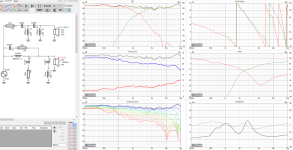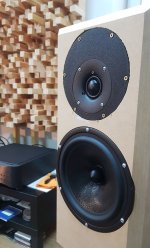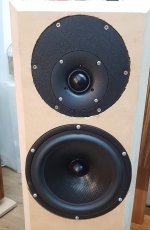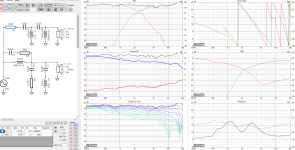I think a 2.5 way with dual U22 would make a very nice speaker, getting rid of the need for speaker stands as well. Dual U22's have surprisingly capable bass quality and impact, and its midrange is unexpectedly clear and natural..As I had also Satori Be tweeters around, waiting for the cabinets for another project, I tried to make 2way with U22.
Another tweeter I wanted to try was TW030WA22 Tetoron, new addition to Wavecor tweeters portfolio.
I did the measurements yesterday, crossover modelling as well, and today I could connect it and start listening.
For now I am pleased with how it sounds, though some fine tuning is still ongoing.
I did the measurements yesterday, crossover modelling as well, and today I could connect it and start listening.
For now I am pleased with how it sounds, though some fine tuning is still ongoing.
Attachments
Great, as always, Pida. When you get time, I'd really appreciate your impressions of the U22 vs 21W, strengths and weaknesses.
@motokok
21W/8555-10
Experiences:
3way (12MU, 9800), woofer duty, LR2 at 450Hz. Additional magnet.
2way, WG + 6600, ~1500Hz LR4
~35l BR (and closed also tried)
3500Hz breakup that needs attention
The sound:
U22REX/P-SL
Experiences:
2way, TW29BN-8 / SB26ADC / TW030WA22, ~2500Hz LR4
~37l BR
no breakup that woould need to be taken care of
very easy to use and to make crossover for, with electrical 2nd order it creates acoustic LR4 due to natural FR rolloff at higher frequencies
The sound:
21W/8555-10
Experiences:
3way (12MU, 9800), woofer duty, LR2 at 450Hz. Additional magnet.
2way, WG + 6600, ~1500Hz LR4
~35l BR (and closed also tried)
3500Hz breakup that needs attention
The sound:
- little bit dull or congested in the midrange compared to U22. The distortion is veri good so it is nothing that could be explained by increased distortion levels. U22 has actually worde distortion performance in midrange area.
- can sound little bit bass heavy, added magnet partially improved that.
- with LR2 at 450Hz, thare was ~2dB broad bump at 100Hz. As 21W is 8ohm the impedance was still ok, so I used this bump to increase overall system sensitivity, and I tuned port little bit higher, and I fine tuned the port length and the amount of damping by listening.
- goes deeper compared to U22
- the bass quality is excellent, though overall on heavier, rounded and slower side (please no comments here, I am trying to describe the impressions) compared to U22
U22REX/P-SL
Experiences:
2way, TW29BN-8 / SB26ADC / TW030WA22, ~2500Hz LR4
~37l BR
no breakup that woould need to be taken care of
very easy to use and to make crossover for, with electrical 2nd order it creates acoustic LR4 due to natural FR rolloff at higher frequencies
The sound:
- it does not go as deep as 21W
- the sound quality of the midrange is very good and I see U22 as one of the best 8" midwoofers suitable for 2way
- it has vivid and tactile bass, it sounds fast, though on the other side it lacks little bit of the full bodied bass compared to 21W (if we can talk about full bodied bass from 8" woofer at all 🙂)
- it also sounds neutral in the terms of its own sound character
- I would not hesitate to use it as woofer in 3way loudspeaker, in ~45l BR
- this could be excellent woofer choice for 3ways with smaller midrange drivers, 3-5" cone midranges or 2-3" middomes, as the distortion measurement is reasonably clean and there is no breakup
I wonder if there are good 12" or even 15" equivalents to U22?
I am experimenting with vintage Philips 12" Alnico full ranger as midrange/bass, and the large Alnico driver does bring some interesting qualities compared to dual U22 8 inchers.
I am experimenting with vintage Philips 12" Alnico full ranger as midrange/bass, and the large Alnico driver does bring some interesting qualities compared to dual U22 8 inchers.
Can you explain in a little more detail what you have tried please?@PKAudio The 700 hz bump in HD is a resonance caused by a radial breakup mode at the cone/surround junction. It can be reduced by applying a viscoelastic dampening compound at the surround cone junction.
I've been doing some experiments with 3D printed TPU rings designed to dampen this area. Its a pain to get the material and adhesive consistent, so a repeatable design could make this easier to control.
Alternatively, a soft neoprene foam ring coated with soft urethane compound could be easier to implement. The problem is usually lack of adhesion to the surround and cone area.
Polypropylene doesn't like to stick to most adhesives, but being a woven fiber, it may substantially help the situation. There's also alot of vibration in that area, so that further complicates it.
I have been mulling adding something that breaks the rotational symmetry similar to the Vifa pentacone approach. Short of pealing away the cone from the surround and cutting away a linear section from its circumference, the best way to do this would be adding something that stiffens the cone locally, e.g. a carbon fibre strand that is tangential to the cone edge.
On the other hand, the woven cone already has its rotational symmetry broken by a bit of four-fold symmetry.
@capslock The challenge of stiffening the cone perimeter is risking a worse resonance with a sharper peak, which is harder to suppress via passive filtering so it doesn't leave abnormal sounding artifacts off center to the peak. Stored energy issues on cone drivers can't be removed by means of electric filtering. Even if its flattened with EQ, it still will be visible in the CSD, albeit in diminished amplitude.
The correct method of dealing with radial cone breakup and resonance (as you've already discovered) is to absorb it at the source. Un-symmetrical and non-proportional cone profiles are the best way to avoid radial cone resonance. Many woven cones already meet this criteria depending on their internal dampening properties, but these can generate self noise if the cone isn't bound internally. The abrasion of unbound cone fibers can be readily audible through increased noise from friction. This hurts low level detail and lowers mechanical Qms. Many well known higher end drivers employ high internal dampening in the cone design, allowing the cone to break up much smoother and softer to control directivity as the frequency increases. The effective radiating cone diameter gradually shrinks as the reproduced frequency rises, until the dust cap ends up being the remaining radiating surface. B&W does this sort of thing with their Continuum cone technology and does so rather well.
Polypropylene itself has a high internal dampening factor and even moreso if its woven material. The Seas woven poly drivers use a tapered side profile to gradually decrease effective radiating surface frequencies climb. This is visible through the controlled directivity of the driver, not having much off axis dips towards the cone's upper rolloff point, similar to the B&W Continuum cone technology.
The correct method of dealing with radial cone breakup and resonance (as you've already discovered) is to absorb it at the source. Un-symmetrical and non-proportional cone profiles are the best way to avoid radial cone resonance. Many woven cones already meet this criteria depending on their internal dampening properties, but these can generate self noise if the cone isn't bound internally. The abrasion of unbound cone fibers can be readily audible through increased noise from friction. This hurts low level detail and lowers mechanical Qms. Many well known higher end drivers employ high internal dampening in the cone design, allowing the cone to break up much smoother and softer to control directivity as the frequency increases. The effective radiating cone diameter gradually shrinks as the reproduced frequency rises, until the dust cap ends up being the remaining radiating surface. B&W does this sort of thing with their Continuum cone technology and does so rather well.
Polypropylene itself has a high internal dampening factor and even moreso if its woven material. The Seas woven poly drivers use a tapered side profile to gradually decrease effective radiating surface frequencies climb. This is visible through the controlled directivity of the driver, not having much off axis dips towards the cone's upper rolloff point, similar to the B&W Continuum cone technology.
Thanks, I hadn't heard that unbound fibers can chafe within their binder.
In case it was not clear enough, here's a picture of a Vifa pentacone from their patent:

The simply cut off sections of the perimeter in an area that will be covered by the surround. This means the reflection from the edge occurs at different times, smearing the resonance out over frequency. Glueing little absorbing strips at the positions were Vifa would make their cuts might have the same effect.
In case it was not clear enough, here's a picture of a Vifa pentacone from their patent:
The simply cut off sections of the perimeter in an area that will be covered by the surround. This means the reflection from the edge occurs at different times, smearing the resonance out over frequency. Glueing little absorbing strips at the positions were Vifa would make their cuts might have the same effect.
In general, all bending of the cone that is not ideal elastic (linear young's modulus) might contribute to the driver's noisefloor:

https://www.klippel.de/fileadmin/kl...ture/Papers/KLIPPEL_Cone_Vibration_Poster.pdf
With ideal elasticity, energy storage of the cone modes shows linear phase behaviour and can be fully equalized. All nonelastic contribution converts motion/bending to heat ("Walkverluste") with almost always nonlinear behaviour that causes distortions.
1st circumferential cone mode beside rocking modes is 4-fold symmetry by principle also in homogenous cone material. Introduction of 5-fold symmetry to the cone geometry surpresses / lowers Q of (mainly) the 1st circumferential mode that appears typically somehow beginning around > 1kHz within usual 5"-7" cone drivers. One example for application is the Vifa cutoff concept you have shown still used in many Scan Speak Discovery midwoofers and the not more available Vifa NE series; another one the ribs used in the aluminum SB15/17 NBAC/CAC drivers from SB Acoustics, that stiffen the cone diagonally but also introduce 5-fold mass distibution to smooth out midrange FR somehow. Scan Speak Illuminator Midwoofers introduce 3-fold symmetry by pressing such structure into the paper cone.
4-fold "prestucturing" of the cone material - e.g. typically by woven fibres - might have advantages that the modes stay stable in one orientation and not "wander" chaotically around the circumference like in homogenous materials what might cause more "restless" polar patterns that affects the indirect sound with additionally modulation.
https://www.klippel.de/fileadmin/kl...ture/Papers/KLIPPEL_Cone_Vibration_Poster.pdf
With ideal elasticity, energy storage of the cone modes shows linear phase behaviour and can be fully equalized. All nonelastic contribution converts motion/bending to heat ("Walkverluste") with almost always nonlinear behaviour that causes distortions.
1st circumferential cone mode beside rocking modes is 4-fold symmetry by principle also in homogenous cone material. Introduction of 5-fold symmetry to the cone geometry surpresses / lowers Q of (mainly) the 1st circumferential mode that appears typically somehow beginning around > 1kHz within usual 5"-7" cone drivers. One example for application is the Vifa cutoff concept you have shown still used in many Scan Speak Discovery midwoofers and the not more available Vifa NE series; another one the ribs used in the aluminum SB15/17 NBAC/CAC drivers from SB Acoustics, that stiffen the cone diagonally but also introduce 5-fold mass distibution to smooth out midrange FR somehow. Scan Speak Illuminator Midwoofers introduce 3-fold symmetry by pressing such structure into the paper cone.
4-fold "prestucturing" of the cone material - e.g. typically by woven fibres - might have advantages that the modes stay stable in one orientation and not "wander" chaotically around the circumference like in homogenous materials what might cause more "restless" polar patterns that affects the indirect sound with additionally modulation.
Last edited:
Crossover fine tuning and listening sessions were fruitful, it sounds excellent and I start liking TW030WA22 a lot. I appreciate it does not sound, yet it sounds quite smooth and cymbals etc. actually sound metal, there is certain sense of the speed I know from hard dome tweeters. This Wavecor seems to hit the right balance. This is my first experience withWavecor tweeters and I have to say I like it, especially considering its price.
Attachments
- Home
- Loudspeakers
- Multi-Way
- SEAS U22REX/P-SL measurements




